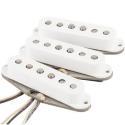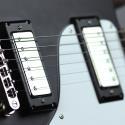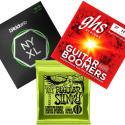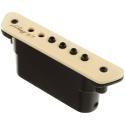Active Vs Passive Pickups - Tips From a Seasoned Guitarist
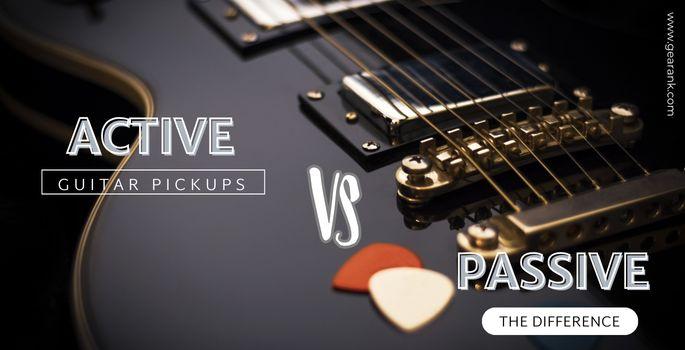
Active vs passive pickups is a tough debate for guitarists. Some would swear by active pickups, while others will only play passive.
On the surface, these two types of pickups may look the same, but in reality, they are substantially different.
For some, the higher headroom of active pickups is the better choice. But for others, the vintage warmth and response of classic passive pickups is hard to resist.
To better understand the differences between the two, it's important to explore how each pickup operates.
So, in this guide, I'll explain what you'll need to know about passive and active pickups. I'll also cover the advantages and disadvantages of both active and passive pickups.
And by the end, you'll know which one suits you: a passive or an active pickup.
What Are Pickups?
A pickup is a crucial part of an electric guitar. Typically made of magnets and copper wire, the pickup sits beneath the strings of a guitar, where it literally "picks up" the vibration of the strings, converting it into sound.
It essentially acts as a microphone for the guitar.
When you play a guitar, the strings start to vibrate. This vibration is picked up by the magnet in the pickup and converted into an electrical signal.
This electric signal serves as your audio signal, which is then sent to your pedals and amps. It is the sound that we hear through the speakers.
What Are Passive Pickups?
Passive pickups are the classic variation pickup. They've been used since the 1950s and are known for their reliability and bright sound.
A guitar with a passive pickup is lively and expressive. Thanks to its multiple wire coils, it can pick up subtle tones with a sensitive touch. Blues players prefer passive pickups for this very reason.
Passive pickups use magnets wrapped in wire. These magnets create a magnetic field, which induces an electric current as the strings vibrate. These vibrations are transformed into an electrical current. The current travels from the pickup to the amplifier, which gets boosted and projected to the speakers.
These pickups have been a mainstay of electric guitars for decades, and the technology has stayed the same for a long time. This is why guitars with passive pickups have a vintage sound.
What Are Active Pickups?
Active pickups are a more recent invention, first introduced in the 1980s. Although not quite as common as passive pickups, they're growing in popularity.
Active pickups operate similarly to passive pickups but use an additional power source to boost the output for a cleaner sound.
Like passive pickups, the active pickup contains magnets wrapped in wire. But most active pickups generally have fewer wire coils, so they are less prone to hum and interference.
However, having fewer wire coils than the passive pickups leads to a lower output.
So, to counteract that low output, active pickups are fitted with an electric preamp. This takes the initial current and boosts it before sending it to the main amp.
While the initial output might be low, active pickups produce higher output courtesy of the built-in preamp. And this high output is the reason why they're at their best when paired with high-gain distortion effects, both in the neck position and bridge position.
However, because of their low initial output, they are not as sensitive as passive pickups. Thankfully, technological advancements have improved the active pickup's fidelity and accuracy.
Active Vs Passive Pickups
In terms of design, the differences between active and passive pickups are minimal. However, even these minor changes greatly affect how the pickups perform.
Whether these features will benefit you or not depends on your style and instrument of choice.
Coils
-
Passive Pickup - Uses more wire coils. The magnets inside the guitar pickup are wrapped multiple times in copper wire. More wires allow them to pick up more sound, resulting in a higher initial output.
-
Active Pickup - Uses fewer wire coils. This creates a lower initial output, which is why they need an additional power source to boost the output.
Power Source
-
Passive Pickup - Do not need a power source.
-
Active Pickup - Typically requires a 9-volts battery power source.
Amplification
-
Passive Pickup - There are no built-in amplification. The electrical signal travels from the guitar to the amp. When it reaches the amplifier, the sound will take on gain.
-
Active Pickup - Some level of amplification takes place earlier. The built-in preamp circuit amplifies the signal for a higher output from the source.
Hum
-
Passive Pickup - The multiple wire coils of passive pickups can pick up more sound and interference. This background noise is the characteristic "hum" of a classic electric guitar.
-
Active Pickup - With fewer coils, active pickups are more resilient to unwanted noise and hum. Which results in a cleaner overall sound. There's less feedback as well, even at a higher gain.
Tone At Volume
Turn the volume up on your amp, and you can notice significant differences between passive and active pickups.
-
Passive Pickup - This has more warmth in the tone, particularly at high volumes. There are fewer high frequencies, which provides for a mellow tone. This is why most passive pickups sound similar to the guitars you hear in older records. It you're a fan of classic guitar tones, then you'll probably end up in the passive pickup camp.
-
Active Pickup - Active pickups retain a similar frequency spectrum even when driven hard. There's less volume roll, so the tone is more consistent. For clarity, especially in heavy metal, active is the more popular choice. Some active pickups, like the Fishman Fluence pickups, come with multiple voicings, courtesy of their layered pickup core. This allows for multiple tone options that you won't get from regular pickups.
Expression
-
Passive Pickup - The hum and tone of a passive pickup give it great sensitivity and an open expression. And expression is an important aspect of tone in music. Those multiple coils also allow the pickup to detect subtle nuances in your playing, adding more range and dynamics compared to the sound that an active pickup produces.
-
Active Pickup - With an active pickup, it's all about clarity. Without the hum, you get a much clearer sound. However, this can reduce expression because the active pickup produce a more consistent flat output rather than a dynamic one.
Price
-
Passive Pickup - A passive pickup is usually much cheaper compared to its counterpart. This is mainly because of its more straightforward design and function.
Also, unlike active pickups, they don't require a battery to be able to function. Making it more cost-efficient in the long run. Passive pickups are the go-to option for those who need budget-friendly pickups.
-
Active Pickup - This is a more complex piece of equipment. Active pickups rely on a battery and an amplifier valve to work.
For that reason, electric guitars and basses with active pickups are generally expensive.
Beginners will find passive pickup instruments a more cost-effective choice. Active pickup users are usually more experienced musicians who are more particular with the tone they are going for.
Upgrading a passive pickup guitar to an active pickup guitar is also costly. Essentially, the entirety of the circuitry will need to be replaced. As well as the basic replacement parts, you'll have to pay for someone to do the work.
If you want to upgrade your pickup, we've made articles about it.
Must-know before upgrading and 4 Things To Consider Before Upgrading Your Pickups
Which Is Better: Passive Or Active Pickup?
Before I dive into the details, it's worth noting that this is a personal opinion. As you'll see, both active and passive pickups have many pros and cons.
Which is best depends on your music style, how you play, the tone you're looking to create, and your budget.
Pros Of Passive Pickups
The warm tone of the passive pickup is one of the main advantages of the design. The added hum makes it mellow and welcoming, while it favors mid-tones at high volumes.
Since it utilizes the same old pickup tech used on old guitars, it sounds vintage.
Warmth and tone give passive pickups versatility. They're used in many types of music, from rock to blues to pop. Many classic rock songs feature passive pickups, making it a sound that's adaptable and familiar.
Multiple wire coils can pick up subtle and sensitive vibrations. Playing with a passive pickup will produce a more expressive and open tone.
While the setup might seem simple, there's a large variety to this type of pickup. Different tones can be created in many ways, from the type of magnet to the thickness of the wire.
You also don't need any extra power sources to run the wire and magnets of passive pickups. This makes them very reliable. You don't have to worry about your battery dying midway through a set! This is particularly beneficial for touring musicians who might spend much time on the road.
Passive pickups are cheaper than their active equivalents. You can find quality options without breaking the bank if you choose passive.
A more popular choice in both electric and acoustic guitars.
Cons Of Passive Pickups
The hum of the passive pickup can be considered an advantage or disadvantage. At high volumes, the hum can be particularly disruptive. The multiple coils also create static and feedback.
The static and disruption often increase when you play near electrical equipment. This can be a big problem in a recording studio when you're trying to achieve a cleaner sound. You might have to do a lot of work in the mix.
There's often frequency loss when using long cable lengths. A low-output passive pickup can struggle to send the signal along a lengthy cable.
To increase output, some manufacturers overwind the wire. This creates a muddier sound. While some like this darker tone, it doesn't work for all music types. Bass players, in particular, tend to avoid this sound.
These issues are particularly prominent with low-quality instruments. You're likely to find a passive pickup produces a muddier sound when used with a cheaper electric guitar or bass.
Pros Of Active Pickups
Active pickups reduce the number of wire coils to lower feedback. This produces a cleaner sound with better clarity. And this clean effect continues even at high gains.
You can turn up the volume and still enjoy the same frequency spectrum. You won't start to lose the higher end, which can be a problem on passive pickups.
The reduced hum of active pickups creates a cleaner recorded sound. You can also use more effects pedals, thanks to the balance of the tone.
Active pickups are incredibly consistent. They perform well with both clean and crunch tones. Plus, you get a tight low end with clarity on the high end.
The low-impedance output of the active pickup means it can handle long cable runs. You won't need to add a buffer to keep your treble.
Impressive performance with high-gain sounds, combined with less hiss and hum, makes active pickups popular with metal players.
Examples of good active pickups include ones made by EMG pickups, Seymour Duncan, and more.
Cons Of Active Pickups
There's less warmth when you play with active pickups. They lack the organic and lively touch, leading to a slightly more clinical tone.
An additional power source is required for the active system to work. While the battery power is responsible for many of the benefits of the active pickup, it's also the main disadvantage.
As the battery runs low, the sound can be affected. When the battery dies, the active pickup is of no use at all.
However, it's worth noting that the battery will likely last for quite a while. Plus, the technology is continuously improving. Some brands have even experimented with USB chargers for the battery.
Guitars with active pickups are more expensive. There are multiple components to the active pickup, so you have to pay extra to achieve that clean sound.
Active pickups don't have the same response and dynamics as the classic passive sound.
Frequently Asked Questions
Are Active Pickups Better For Metal Music?
Metal guitar players tend to turn to active pickups thanks to the clean sound at a higher gain. The high output and lack of "hiss" work with the punchy sound of metal.
However, some old-school metal players would still want the raw sound they get from a passive pickup.
Are Active Pickups Louder?
Active pickups use a built-in preamp to create a higher output for a louder sound.
If you like clarity at high volume, this is a key difference in the active vs passive pickups debate.
What are the other types of pickup?
Single-Coil Pickups
The most common form of pickup is the single-coil pickup. These styles use an individual magnet under each string, wrapped with one copper wire.
Single-coil pickups perform best with clean amp settings, producing a bright tone.
Humbucker Pickups
Another common type is the Humbucker pickup. It uses two wire coils. Each coil is placed in the opposite direction. The double coil allows the humbucker to literally "buck" the "hum"--they cancel out the interference.
Humbucker pickups produce a punchy sound thanks to that lack of hum. They're great for creating a darker distortion.
Why are pickups magnetic?
Vibrations are produced every time you pluck or strum a guitar string. Pick up magnets and a coil/wire (mostly copper), then convert these vibrations into electric signals sent to an amplifier.
Alnico or ceramic are the most commonly used magnets on electric guitar pickups. Alnico magnets are known for their warm tone and medium output. Ceramic magnets have a punchier tone and a higher output.
Conclusion
Active or passive pickups are both a great choice, depending on how you're using them.
Warm-raw sound = passive guitar pickups;
Clean-compressed guitar tone = active pickups.
Both these pickups produce different sound qualities that are distinct and unique. Take advantage of them.
Consider the type of sound you want to produce. Find the pickup that best matches it and your personal taste.
In the end, it's all about your preferences.
The active vs passive pickups discussion is also important when buying a guitar. You should get the guitar that has the pickup type that you prefer.
Contributors
Jerome Arcon - Co-writer



